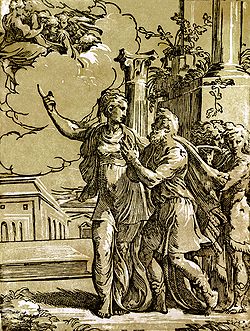Antonio da Trento: Difference between revisions
Content deleted Content added
m →top: archive link repair, may include: archive.* -> archive.today, and http->https for ghostarchive.org and archive.org (wp:el#Specifying_protocols) |
m edit cats, stub tag |
||
| Line 1: | Line 1: | ||
[[File:Antonio da Trento - The Tiburtine sibyl and the Emperor Augustus.jpg|thumb|right|250px|Antonio da Trento, ''[[Tiburtine Sibyl]] and the Emperor [[Augustus]]'']] |
[[File:Antonio da Trento - The Tiburtine sibyl and the Emperor Augustus.jpg|thumb|right|250px|Antonio da Trento, ''[[Tiburtine Sibyl]] and the Emperor [[Augustus]]'']] |
||
'''Antonio da Trento''' (1508–1550) was an Italian engraver. |
'''Antonio da Trento''' (1508–1550) was an Italian [[engraver]]. |
||
Da Trento was born in [[Trento]]. He specialized in [[chiaroscuro woodcut]]s, especially of religious themes and scenes.<ref name="ref1">{{cite web|url=http://www.answers.com/topic/antonio-da-trento-1|title=Brief Bio Antonio da Trento|accessdate=2010-03-30}}</ref> Da Trento probably first learned wood engraving from [[Ugo da Carpi]].<ref name="ref2">{{cite book|url=https://books.google.com/books?id=K14OAAAAQAAJ&q=parmigiano+%22sybil%22&pg=PA367|title=A Biographical Dictionary; Containing an Historical Account of All the Engravers, From the Earliest Period of their Art to the Present Time]'' [etc.], Strutt, Joseph (1786), J. Davis, for Robert Faulder, London. Volume II, p. 367|accessdate=2010-03-30|last1=Strutt|first1=Joseph|year=1786}}</ref> He later |
Da Trento was born in [[Trento]]. He specialized in [[chiaroscuro woodcut]]s, especially of religious themes and scenes.<ref name="ref1">{{cite web|url=http://www.answers.com/topic/antonio-da-trento-1|title=Brief Bio Antonio da Trento|accessdate=2010-03-30}}</ref> Da Trento probably first learned wood engraving from [[Ugo da Carpi]].<ref name="ref2">{{cite book|url=https://books.google.com/books?id=K14OAAAAQAAJ&q=parmigiano+%22sybil%22&pg=PA367|title=A Biographical Dictionary; Containing an Historical Account of All the Engravers, From the Earliest Period of their Art to the Present Time]'' [etc.], Strutt, Joseph (1786), J. Davis, for Robert Faulder, London. Volume II, p. 367|accessdate=2010-03-30|last1=Strutt|first1=Joseph|year=1786}}</ref> He was later a disciple of [[Parmigianino]], and afterwards within the [[School of Fontainebleau]].<ref name="ref3">{{cite web|url=http://www.colorado.edu/cuartmuseum/xF_datrento.html |archive-url=https://archive.today/20071019234351/http://www.colorado.edu/cuartmuseum/xF_datrento.html |url-status=dead |archive-date=2007-10-19 |title=Style and Manner of Antonio da Trento |accessdate=2009-11-16 }} </ref> |
||
Da Trento's technique involved creating three separate blocks for each print. The first was for the outlines, the second for shadows, and the third was for the lighter tints. Three documented works of his are ''The Beheading of [[Saint Peter|St. Peter]] and [[Paul of Tarsus|St. Paul]]'', ''The [[Tiburtine Sibyl]] showing the [[Mary (mother of Jesus)|Virgin Mary]], with the Infant [[Christ]]'', and ''[[Cupid and Psyche|Psyche]] Saluted by the People with the Honors of Divinity''.<ref name="ref2"/> |
Da Trento's technique involved creating three separate blocks for each print. The first was for the outlines, the second for shadows, and the third was for the lighter tints. Three documented works of his are ''The Beheading of [[Saint Peter|St. Peter]] and [[Paul of Tarsus|St. Paul]]'', ''The [[Tiburtine Sibyl]] showing the [[Mary (mother of Jesus)|Virgin Mary]], with the Infant [[Christ]]'', and ''[[Cupid and Psyche|Psyche]] Saluted by the People with the Honors of Divinity''.<ref name="ref2"/> |
||
| Line 17: | Line 17: | ||
[[Category:1550 deaths]] |
[[Category:1550 deaths]] |
||
[[Category:Italian engravers]] |
[[Category:Italian engravers]] |
||
[[Category:16th-century Italian |
[[Category:16th-century Italian artists]] |
||
[[Category:Italian male |
[[Category:Italian male artists]] |
||
[[Category:People from Trento]] |
[[Category:People from Trento]] |
||
{{Italy- |
{{Italy-engraver-stub}} |
||
Revision as of 18:28, 2 April 2022

Antonio da Trento (1508–1550) was an Italian engraver.
Da Trento was born in Trento. He specialized in chiaroscuro woodcuts, especially of religious themes and scenes.[1] Da Trento probably first learned wood engraving from Ugo da Carpi.[2] He was later a disciple of Parmigianino, and afterwards within the School of Fontainebleau.[3]
Da Trento's technique involved creating three separate blocks for each print. The first was for the outlines, the second for shadows, and the third was for the lighter tints. Three documented works of his are The Beheading of St. Peter and St. Paul, The Tiburtine Sibyl showing the Virgin Mary, with the Infant Christ, and Psyche Saluted by the People with the Honors of Divinity.[2]
References
- ^ "Brief Bio Antonio da Trento". Retrieved 2010-03-30.
- ^ a b Strutt, Joseph (1786). A Biographical Dictionary; Containing an Historical Account of All the Engravers, From the Earliest Period of their Art to the Present Time] [etc.], Strutt, Joseph (1786), J. Davis, for Robert Faulder, London. Volume II, p. 367. Retrieved 2010-03-30.
- ^ "Style and Manner of Antonio da Trento". Archived from the original on 2007-10-19. Retrieved 2009-11-16.
Wikimedia Commons has media related to Antonio da Trento.
